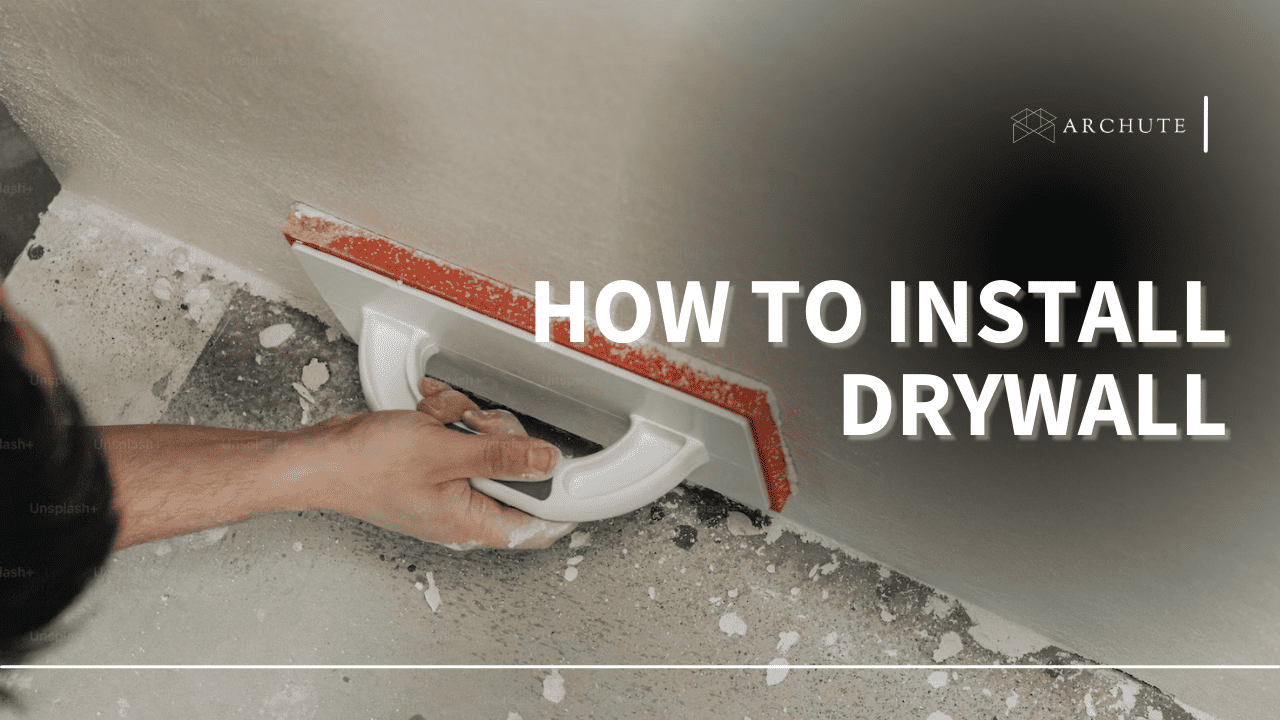Installing drywall can be a strenuous task for even the most experienced DIYers, who are often advised not to take it upon themselves unless they clearly know what they are doing.
Drywall installations require a skilled and experienced professional, but with that said, however, it is good to understand the nuances of this process to ensure the best possible outcomes even while working with a professional.
In this article, we cover everything there is to know about drywall installations, from preparing the surface to sanding, painting, and their long-term upkeep; we've got it all covered.
That being said, however, this is a task that comes with a learning curve and cannot be accomplished by novices without wasting significant amounts of time, money, material, and effort, so unless you are planning to foray into the drywall panel installations business, make sure to tread lightly.
Tools & Materials Required
Before starting the installation process, it is crucial to get all the materials and tools in one place so as to remain focused on the job at hand instead of running behind different items as and when they are necessary.
Here are the basic tools and materials that would be required for a drywall installation,
1. Drywall Sheets
To get started, it is important to determine the right size of sheets for your projects, with the 4 feet by 8 feet sheets being fairly common and almost a standard, but there are other variations in the fray. This includes 4 feet by 10 feet, 4 feet by 12 feet, and more.
In order to avoid wastage and expensive mistakes, it is good to measure the area for the sheet of drywall before installation before narrowing down to the ideal sheet sizes and their quantity to best suit your requirements.
2. Drywall Screws
Next comes the screws, which need to be long enough to penetrate the drywall to reach the studs or joists behind the wall.
The most commonly used size here is 1 ⅝ inches, but depending on the thickness of your drywall or insulation, longer drywall screws might be required.
Drywall screws can be fairly versatile, and even smaller ones can do the trick in a number of cases. However, be wary of overextending them, as they might quicken quickly and ruin the expensive drywall sheets for good.

3. Joint Compound
In order to fill and smoothen the seams between drywall sheets, a pre-mixed or powdered joint compound is mixed with water before being feathered across the seams with the right feathering product or a gentle brush.
4. Taping Knife
For applying the joint compound accurately across the seams, a taping knife comes in handy.
Even though it comes in different shapes and sizes, a 6-inch knife or an 8-inch knife is perfectly suited for most projects.
5. Drywall Saw
A drywall saw is essentially a handheld tool that allows you to cut the sheets accurately and to the right size.
This can be done with a utility knife too, but a narrow, long blade of a drywall saw does a lot better when it comes to easily making its way through a drywall sheet and is, thus, more efficient.
6. Drill With A Screwdriver Bit
In order to attach the sheets to the studs or joists behind the wall, a drill with the right screwdriver bit is critical.
This is a very delicate process, and the potential to cause damage to the drywall is quite high, and as a result, professionals and DIYers alike are suggested to work with a gentle hand, preferably using a drill with a clutch to prevent instances of overdriving.
7. Pencil
As is the case with most home improvement projects, there will be plenty of measurements, notes, and markings to keep track of things and execute them to perfection.
This makes the humble pencil a very useful tool during the course of such projects, allowing for quick markings, which can then be erased without leaving any permanent marks or blemishes on the finished surface of the drywall.
8. T-Square and other personal preferences
Often regarded as a draftsman or tradesman's best companion, a T-square is a very useful tool when it comes to technical drawings and perfect alignments.
It is rather indispensable if you want to hang drywall with perfect accuracy and adherence to plans and drawings.
Similarly, there are a slew of other tools that come in handy when you want to install drywall, but beyond the ones listed above, most of them are not absolutely essential, and are merely good to have.
How To Install Drywall? A Step-By-Step Guide
Once you have the essential tools and materials handy, it is time to get started with the installation process to hang the drywall.

1. Measure The Area
Before you put the hammer to the nail, it is critical to have a proper plan, with markings and measurements in place to guide your hands intuitively as you start to work.
This ideally should be done even before you acquire the materials, as it helps determine the right amount of drywall sheets required. It is further recommended to make use of a measuring tape, pencil, and a T-square to make precise measurements and markings.
It is also important to take into account any openings such as doors, windows, electrical sockets, etc., and leave the necessary gaps for the same.
Without this, the process of installing turns into multiple rounds of trials and errors, trying to match different window and door openings at their exact sizes.
2. Cut The Drywall Sheets
Once you have the right measurements, you can start cutting the drywall sheets to match the exact correct sizes. A drywall saw is perfect in this regard, a utility knife could work as well for experienced professionals but is relatively difficult to ensure a perfect match with the drywall knife measurements.
Make sure to mark the cut lines accurately with a pencil before running the saw through them, this further helps in maintaining straight lines and accurate cuts.
3. Install The Drywall
Now that you have the sheets perfectly cut and ready for installation, you can follow the steps below for the perfect installation.
- It's best to get started with the ceiling first. Place the first sheet of the drywall against the ceiling joists, making sure that it is flush with the adjacent wall.
- Make sure to use a drill with a screwdriver bit to attach the drywall sheet to the joists. Place the screws at least 12 inches apart, starting from the center and working your way toward the edges.
- The drywall screws need to be flush with the surface of the drywall but not too deep, as going deeper can cause the paper to tear or the screw to break through the surface.
- Repeat this same process across the remaining sheets while making sure to stagger the seams between the sheets. This helps provide additional strength and prevents frequent cracking.

4. Tape & Finish The Seams
Once all the sheets are in place, it is time to start taping and finishing the seams in order to achieve a neat and professional-looking finish.
- Get started by mixing your joint compound with water, following which you can start applying it to the seams, preferably using a taping knife.
- Make sure to cover all drywall screws and any gaps that persist between the sheets to achieve the desired look.
- Following this, you can then place drywall tape over the joint compound and start smoothing it using your hands or a taping knife.
- Here, it is crucial that the tape is firmly in place, sticking to the surface, leaving no room for air bubbles or wrinkles.
- Apply another coat of joint compound upon this tape using a taping knife to further feather out the edges.
- Continue to repeat this process with additional coats until the seams are smooth and even, having no visible wrinkles or inconsistencies.
- There will be certain bumps and ridges, which can be dealt with by gently sanding the seams using sandpaper. Once you get rid of them, you can softly wipe the surface with a damp cloth before leaving it to dry for either wallpaper or a fresh paint coat.
Common Mistakes & How To Avoid Them?
As discussed above, it is very easy for drywall installations to go wrong for often the simplest of errors, and in this section, we cover a few common mistakes to avoid.
i. Not Measuring Accurately
Inaccurate measurements are often the most common reasons behind failed installations.
Even if your measurements are off by a few millimeters, it is enough to create unsightly gaps, uneven seams, and wasted materials.
II. Using The Wrong Type of Screws
Most people falsely underestimate the importance of screws and using the right type of screws when it comes to drywall projects.
The screws used must be long enough to attach the drywall to the studs or joists after penetrating through the walls. Without this, the drywall can soon start to sag or pull away from the fall within just a few short weeks.
III. Not Invoicing Correctly For Drywall Work
This doesn't pertain to DIYers but to contractors and tradesmen who work with dry walls and their installations.
A significant number of these professionals fail to earn a sizable return for their efforts in installing drywall. This can largely be attributed to incorrect or inadequate invoicing practices.
Given the nature of this service, tradesmen would do well to use specialized solutions such as Joist, an estimating and invoicing app for contractors.
Final Words
By taking the necessary steps and avoiding the common mistakes discussed above, it is very well possible to install drywall perfectly and professionally, all by yourself.
That being said, however, there are far too many pitfalls in this task, and if you don't regularly work with drywalls, it is best to avoid trying, as such an attempt can only be termed as being penny-wise and pound foolish!
















